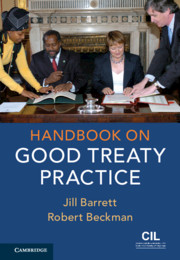Book contents
- Handbook on Good Treaty Practice
- Reviews
- Centre for International Law, National University of Singapore (CIL-NUS)
- Handbook on Good Treaty Practice
- Copyright page
- Contents
- Contents
- Figures
- Boxes
- Acknowledgements
- Table of Cases
- Table of Treaties and other International Instruments
- Table of Legislation
- Abbreviations
- 1 Introduction to Good Treaty Practice
- 2 Organising Treaty Work in Governments and International Organisations
- 3 Treaties and Other Kinds of International Instruments
- 4 Managing and Using Treaty Collections
- 5 Making a New Treaty: Negotiation, Drafting and Production
- 6 Preparing to Become Party to a Treaty
- 7 Becoming Party to a Treaty: Consent to Be Bound and Entry into Force
- 8 Continuing Engagement with the Treaty Throughout Its Life
- 9 Ending Treaty Relations
- 10 The Future of Treaty Practice
- Annexes
- Glossary
- Suggested Further Reading
- Index
4 - Managing and Using Treaty Collections
Published online by Cambridge University Press: 27 January 2020
- Handbook on Good Treaty Practice
- Reviews
- Centre for International Law, National University of Singapore (CIL-NUS)
- Handbook on Good Treaty Practice
- Copyright page
- Contents
- Contents
- Figures
- Boxes
- Acknowledgements
- Table of Cases
- Table of Treaties and other International Instruments
- Table of Legislation
- Abbreviations
- 1 Introduction to Good Treaty Practice
- 2 Organising Treaty Work in Governments and International Organisations
- 3 Treaties and Other Kinds of International Instruments
- 4 Managing and Using Treaty Collections
- 5 Making a New Treaty: Negotiation, Drafting and Production
- 6 Preparing to Become Party to a Treaty
- 7 Becoming Party to a Treaty: Consent to Be Bound and Entry into Force
- 8 Continuing Engagement with the Treaty Throughout Its Life
- 9 Ending Treaty Relations
- 10 The Future of Treaty Practice
- Annexes
- Glossary
- Suggested Further Reading
- Index
Summary
For any State or IO, the accurate and efficient management of treaty records is of fundamental importance. This chapter looks at the how’s and whys of keeping treaty records, where the information comes from and what treaty officials do with it. It looks at ways of managing all treaty-related information and permanently preserving treaties and associated documents, and what one needs to consider when doing so. It addresses what different users might need treaty information for, and the ways in which they might use it. It looks first at internal users such as the Treaty Office and those closely associated with it, such as legal advisers and policy makers within the government or IO. It then considers the needs of ‘external users‘ in effect, everyone else. Lastly, it considers the role of depositaries.
Keywords
- Type
- Chapter
- Information
- Handbook on Good Treaty Practice , pp. 123 - 157Publisher: Cambridge University PressPrint publication year: 2020

